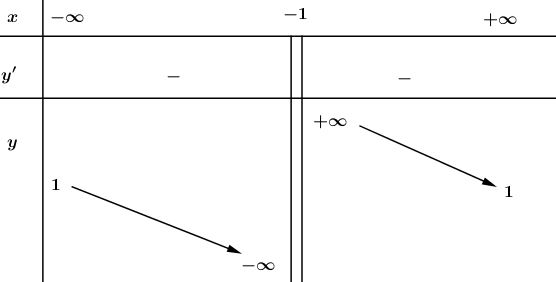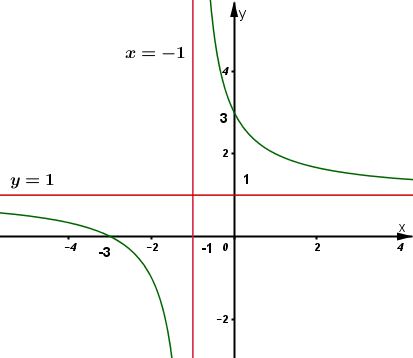Video hướng dẫn giải
LG a
a) Khảo sát sự biến thiên và vẽ đồ thị \(\displaystyle (C)\) của hàm số \(\displaystyle y = {{x + 3} \over {x + 1}}.\)
Phương pháp giải:
Khảo sát và vẽ đồ thi qua các bước đã được học.
Lời giải chi tiết:
Xét hàm số: \(\displaystyle y = {{x + 3} \over {x + 1}}\)
Tập xác định : \(\displaystyle D=\mathbb R\backslash {\rm{\{ }} - 1\} \)
* Sự biến thiên:
\(\displaystyle y' = {{ - 2} \over {{{(x + 1)}^2}}} < 0,\forall x \in D\)
- Hàm số nghịch biến trên khoảng: \(\displaystyle (-\infty;-1)\) và \(\displaystyle (-1;+\infty)\)
- Cực trị: Hàm số không có cực trị.
- Tiệm cận:
\(\displaystyle \eqalign{& \mathop {\lim }\limits_{x \to - {1^ - }} y = - \infty \cr & \mathop {\lim }\limits_{x \to - {1^ + }} y = + \infty \cr & \mathop {\lim }\limits_{x \to \pm \infty } y = 1 \cr} \)
Tiệm cận đứng: \(\displaystyle x = -1.\)
Tiệm cận ngang: \(\displaystyle y = 1.\)
Bảng biến thiên:
* Đồ thị:
Đồ thị hàm số giao \(\displaystyle Ox\) tại \(\displaystyle (-3;0)\), giao \(\displaystyle Oy\) tại \(\displaystyle (0;3)\)
Đồ thị hàm số nhận điểm \(\displaystyle I(-1;1)\) làm tâm đối xứng.
LG b
b) Chứng minh rằng với mọi giá trị của \(\displaystyle m\), đường thẳng \(\displaystyle y = 2x + m\) luôn cắt \(\displaystyle (C)\) tại hai điểm phân biệt \(\displaystyle M\) và \(\displaystyle N.\)
Phương pháp giải:
Chứng minh phương trình hoành độ giao điểm của hai đồ thị hàm số có hai nghiệm phân biệt khác \(\displaystyle -1\) với mọi \(\displaystyle m.\)
Lời giải chi tiết:
Xét phương trình có nghiệm là hoành độ giao điểm của \(\displaystyle (C)\) và đường thẳng (d): \(\displaystyle y = 2x + m\) (1)
\(\displaystyle \eqalign{
& {{x + 3} \over {x + 1}} = 2x + m \Leftrightarrow x + 3 = (2x + m)(x + 1) \cr
& \Leftrightarrow 2{x^2} + (m + 1)x + m - 3 = 0,x \ne - 1 \cr} \)
\(\displaystyle Δ = (m+1)^2– 4.2(m-3) \\ = m^2+2m+1-8m+24 \\= m^2– 6m + 25\\ = (m-3)^2+ 16> 0 \)
\(\displaystyle \Rightarrow \) (1) luôn có hai nghiệm phân biệt.
Lại có: \(\displaystyle f\left( { - 1} \right) = 2.{\left( { - 1} \right)^2} - \left( {m + 1} \right) + m - 3 = - 2 \ne 0\) hay phương trình (1) có nghiệm khác \(\displaystyle -1\).
Vậy phương trình (1) luôn có 2 nghiệm phân biệt khác \(\displaystyle -1\) với mọi \(\displaystyle m.\)
Vậy (d) luôn cắt (C) tại hai điểm phân biệt \(\displaystyle M, N\) (hoành độ của \(\displaystyle M, N\) chính là nghiệm của (1)).
LG c
c) Xác định m sao cho độ dài \(\displaystyle MN\) là nhỏ nhất.
Phương pháp giải:
Với hai điểm \(\displaystyle M\) và \(\displaystyle N\) tìm được ở câu trên, tính độ dài đoạn thẳng \(\displaystyle MN\) theo công thức: \(\displaystyle MN = \sqrt {{{\left( {{x_N} - {x_M}} \right)}^2} + {{\left( {{y_N} - {y_M}} \right)}^2}} = \sqrt {f\left( x \right)} .\)
+) Khảo sát và tìm giá trị nhỏ nhất của hàm số \(\displaystyle y=f(x)\) từ đó suy ra độ dài nhỏ nhất của \(\displaystyle MN.\)
Lời giải chi tiết:
Gọi \(\displaystyle M\left( {{x_M};\;{y_M}} \right)\) và \(\displaystyle N\left( {{x_N};\;{y_N}} \right)\) là hai giao điểm của \(\displaystyle (C)\) và đường tahnwgr \(\displaystyle y=2x+m.\)
Theo định lí Vi-et ta có:\(\displaystyle \left\{ \matrix{{x_M} + {x_N} = - {{m + 1} \over 2} \hfill \cr {x_M}.{x_N} = {{m - 3} \over 2} \hfill \cr} \right.\)
\(\displaystyle \begin{array}{l}
M{N^2} = {\left( {{x_M} - {x_N}} \right)^2} + {\left( {{y_M} - {y_N}} \right)^2}\\
= {\left( {{x_M} - {x_N}} \right)^2} + {\left[ {2{x_M} + m - \left( {2{x_N} + m} \right)} \right]^2}\\
= {\left( {{x_M} - {x_N}} \right)^2} + 4{\left( {{x_M} - {x_N}} \right)^2}\\
= 5{\left( {{x_M} - {x_N}} \right)^2}\\
= 5\left[ {{{\left( {{x_M} + {x_N}} \right)}^2} - 4{x_M}{x_N}} \right]\\
= 5\left[ {{{\left( { - \frac{{m + 1}}{2}} \right)}^2} - 4.\frac{{m - 3}}{2}} \right]\\
= 5\left( {\frac{{{m^2} + 2m + 1}}{4} - 2m + 6} \right)\\
= 5.\frac{{{m^2} - 6m + 25}}{4} \\ = \frac{5}{4}\left[ {\left( {{m^2} - 6m + 9} \right) + 16} \right]\\
= \frac{5}{4}\left[ {{{\left( {m - 3} \right)}^2} + 16} \right].
\end{array}\)
Ta có: \(\displaystyle {\left( {m - 3} \right)^2} \ge 0\;\forall \;m \Rightarrow {\left( {m - 3} \right)^2} + 16 \ge 16\)
\(\displaystyle \begin{array}{l}
\Rightarrow M{N^2} \ge \frac{5}{4}.16 = 20.\\
\Rightarrow MN \ge 2\sqrt 5 .
\end{array}\)
Dấu "=" xảy ra \(\displaystyle \Leftrightarrow m - 3 = 0 \Leftrightarrow m = 3.\)
Vậy độ dài \(\displaystyle MN\) nhỏ nhất bằng \(\displaystyle 2\sqrt5\) khi \(\displaystyle m=3.\)
LG d
d) Tiếp tuyến tại một điểm \(\displaystyle S\) bất kì của \(\displaystyle (C)\) luôn cắt hai tiệm cận của \(\displaystyle (C)\) tại \(\displaystyle P\) và \(\displaystyle Q\). Chứng minh rằng \(\displaystyle S\) là trung điểm của \(\displaystyle PQ\).
Phương pháp giải:
Gọi \(\displaystyle S(x_0;\, y_0)\) là 1 điểm bất kì thuộc đồ thị hàm số \(\displaystyle (C).\) Khi đó phương trình tiếp tuyến của đồ thị hàm số tại \(\displaystyle S\) là: \(\displaystyle \Delta: \, y = y'\left( {{x_0}} \right)\left( {x - {x_0}} \right) + {y_0}.\)
+) Tìm các giao điểm \(\displaystyle P, \, \, Q\) của tiếp tuyến \(\displaystyle \Delta\) với các đường tiệm cận.
+) Khi đó \(\displaystyle S\) là trung điểm của \(\displaystyle PQ\Leftrightarrow \left\{ \begin{array}{l}{x_0} = \frac{{{x_P} + {x_Q}}}{2}\\{y_0} = \frac{{{y_P} + {y_Q}}}{2}\end{array} \right..\)
Lời giải chi tiết:
Giả sử \(\displaystyle S(x_0;y_0)\) là điểm bất kì thuộc (C)
Phương trình tiếp tuyến \(\displaystyle Δ\) của (C) tại \(\displaystyle S\) là:
\(\displaystyle \eqalign{
& y - y_0 = y'({x_0})(x - {x_0}) \cr
& \Leftrightarrow y = {{ - 2} \over {{{({x_0} + 1)}^2}}}(x - {x_0}) + {{{x_0} + 3} \over {{x_0} + 1}} \cr} \)
Tiệm cận đứng: \(\displaystyle x=-1\) và tiệm cận ngang: \(\displaystyle y=1.\)
Giả sử \(\displaystyle Δ\) cắt tiệm cận ngang tại \(\displaystyle P(x_P; 1)\). Khi đó:
\(\displaystyle \begin{array}{l}
\frac{{ - 2}}{{{{\left( {{x_0} + 1} \right)}^2}}}\left( {{x_P} - {x_0}} \right) + \frac{{{x_0} + 3}}{{{x_0} + 1}} = 1\\
\Leftrightarrow - 2{x_P} + 2{x_0} + x_0^2 + 4{x_0} + 3 = x_0^2 + 2{x_0} + 1\\
\Leftrightarrow - 2{x_P} = - 4{x_0} - 2\\
\Leftrightarrow {x_P} = 2{x_0} + 1\\
\Rightarrow P\left( {2{x_0} + 1;\;1} \right).
\end{array}\)
\(\displaystyle Δ\) cắt tiệm cận đứng tại \(\displaystyle Q( - 1; y_Q).\) Khi đó:
\(\displaystyle \begin{array}{l}
\frac{{ - 2}}{{{{\left( {{x_0} + 1} \right)}^2}}}\left( { - 1 - {x_0}} \right) + \frac{{{x_0} + 3}}{{{x_0} + 1}} = {y_Q}\\
\Leftrightarrow 2 + 2{x_0} + x_0^2 + 4{x_0} + 3 = {y_Q}{\left( {{x_0} + 1} \right)^2}\\
\Leftrightarrow x_0^2 + 6{x_0} + 5 = {y_Q}{\left( {{x_0} + 1} \right)^2}\\
\Leftrightarrow \left( {{x_0} + 1} \right)\left( {{x_0} + 5} \right) = {y_Q}{\left( {{x_0} + 1} \right)^2}\\
\Leftrightarrow {y_Q} = \frac{{{x_0} + 5}}{{{x_0} + 1}}.\\
\Rightarrow Q\left( { - 1;\;\frac{{{x_0} + 5}}{{{x_0} + 1}}} \right)
\end{array}\)
\(\displaystyle \Rightarrow \left\{ \begin{array}{l}
{x_P} + {x_Q} = 2{x_0} + 1 - 1 = 2{x_0} = 2{x_S}\\
{y_P} + {y_Q} = 1 + \frac{{{x_0} + 5}}{{{x_0} + 1}} = \frac{{2{x_0} + 6}}{{{x_0} + 1}} = \frac{{2\left( {{x_0} + 3} \right)}}{{{x_0} + 1}} = 2{y_0} = 2{y_S}.
\end{array} \right.\)
Vậy \(\displaystyle S\) là trung điểm của \(\displaystyle PQ\).



